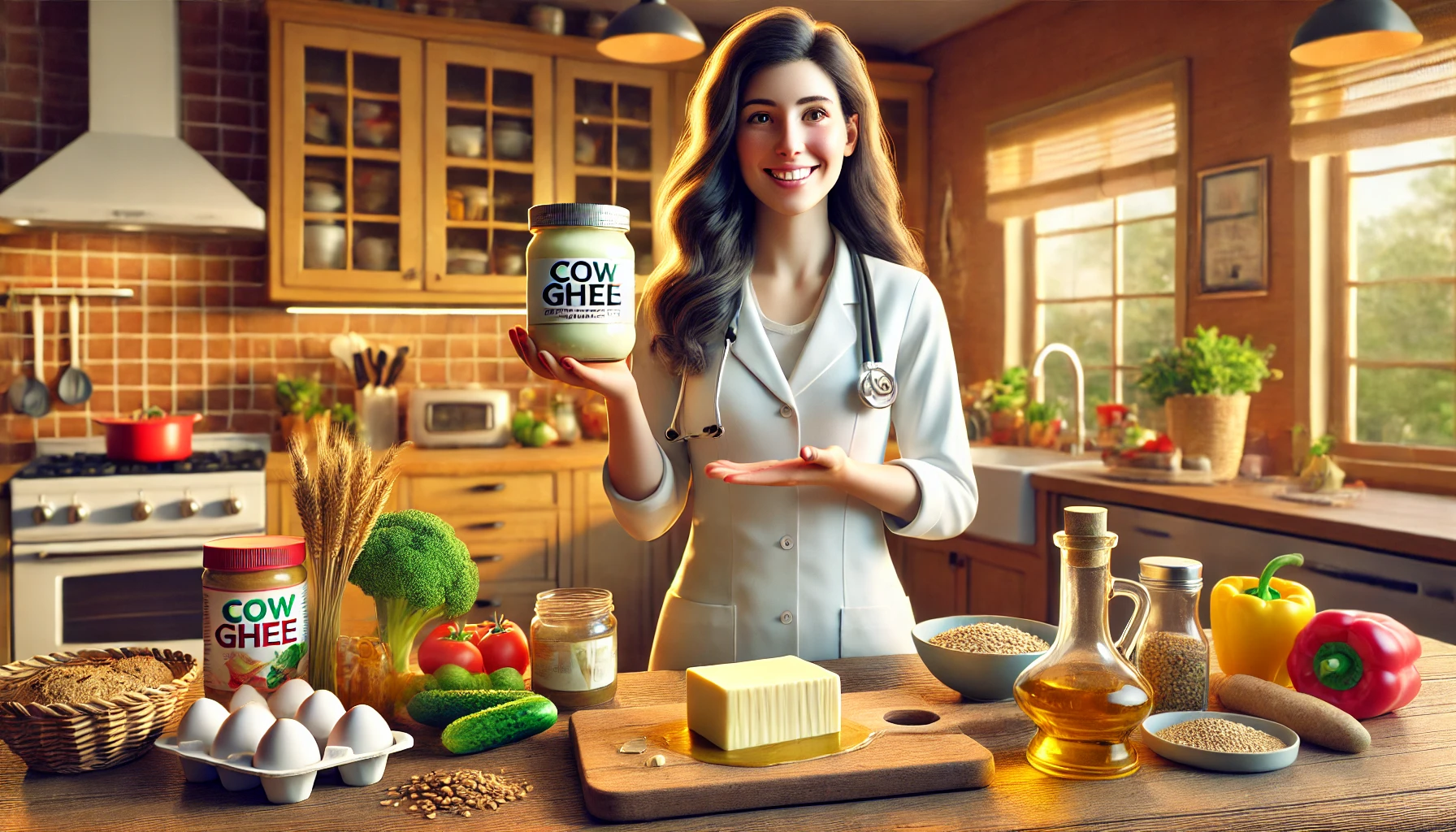When it comes to healthy eating, few foods spark as much debate as cow ghee. For some, it’s the golden elixir that adds richness to every dish, while others avoid it like the plague, fearing it might pack on the pounds. But with all the myths swirling around, it’s easy to get confused—does cow ghee actually lead to weight gain, or is it a misunderstood superfood? In this article, we’ll dive into the science behind cow ghee, explore its health benefits, and separate fact from fiction to help you make an informed decision about whether this traditional ingredient deserves a place in your kitchen. Spoiler alert: it might not be as fattening as you think!
Cow ghee, a staple in traditional Indian kitchens, has been revered for centuries not just as a culinary delight, but also for its healing properties in Ayurvedic medicine. Yet, despite its long history and nutritional benefits, there’s still confusion about whether it’s a health food or just another fattening indulgence. In this article, we’ll explore the myths surrounding cow ghee, its actual impact on your health, and whether it can be part of a balanced diet without contributing to unwanted weight gain.
Table of Contents
Understanding Cow Ghee: What Exactly Is It?
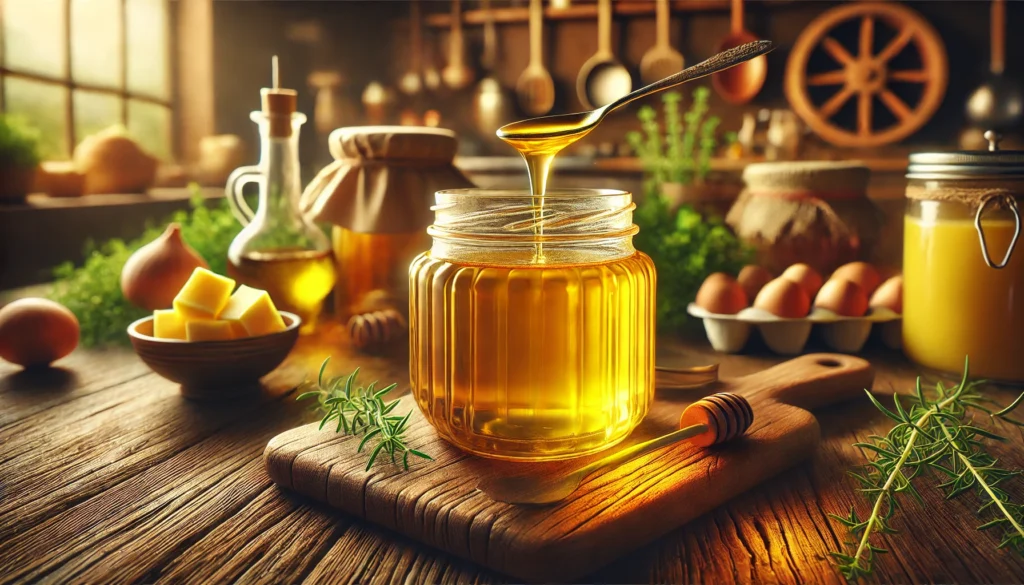
- What is Cow Ghee?
Cow ghee is clarified butter made from the milk of cows, a process that removes milk solids, leaving behind pure butterfat. Unlike regular butter, which contains milk proteins and water, ghee is 100% fat. Its rich, golden hue and nutty flavor make it a versatile ingredient in Indian cuisine and beyond. Historically, ghee has been used not just in cooking, but also in traditional medicine for its healing properties, as it is believed to support digestion, immunity, and overall vitality.
Ghee is also known for its high smoke point, which makes it ideal for high-heat cooking without breaking down into harmful compounds.
- Differences Between Cow Ghee and Other Types of Ghee
While cow ghee is made from cow’s milk, ghee can also be derived from the milk of other animals, such as buffalo. The key differences lie in taste, fat composition, and nutritional benefits. Buffalo ghee, for instance, is richer in fat and has a more intense flavor than cow ghee, which tends to be lighter and more neutral.
Additionally, some people prefer cow ghee because it’s considered to be more easily digestible, making it a better option for individuals with sensitive stomachs. Plant-based oils, on the other hand, such as olive oil or sunflower oil, have a different composition of fats and are lower in the fat-soluble vitamins that ghee contains.
- How is Cow Ghee Made?
The process of making ghee involves simmering butter made from cow’s milk until the water evaporates and the milk solids separate and settle. What remains is clarified butter, which is then strained to remove any remaining impurities. The result is a golden, aromatic fat that has a long shelf life and retains most of the nutrients found in butter, without the lactose and casein that some individuals find difficult to digest.
Because of its purity and unique preparation method, cow ghee is often considered more nutritious than regular butter, which retains both milk solids and moisture. The absence of these solids in ghee contributes to its longer shelf life and its stability at higher temperatures.
The Myth of Cow Ghee and Weight Gain
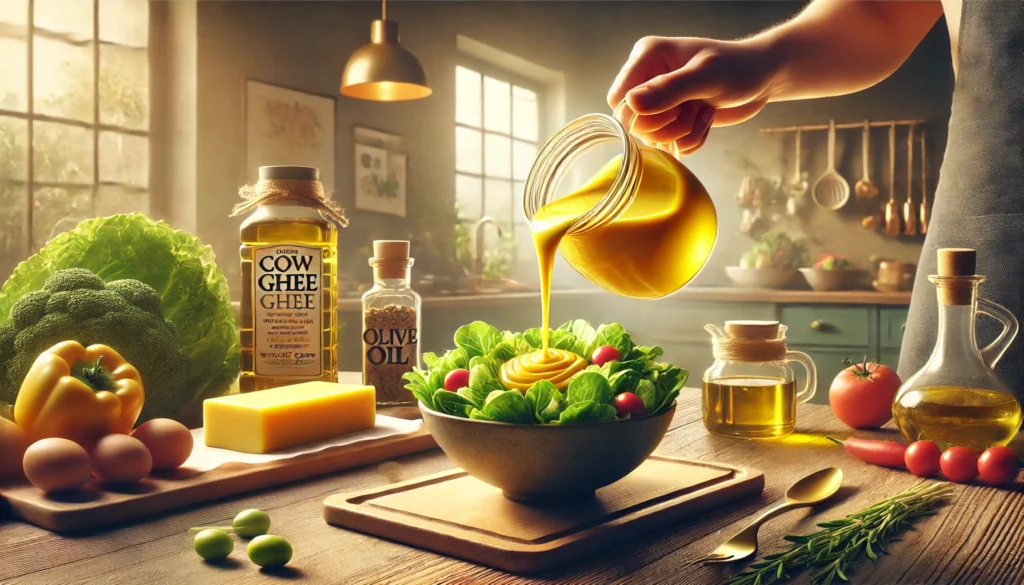
- The Common Perception
Cow ghee often gets a bad reputation due to its high-fat content. Many people believe that eating ghee will lead to weight gain, as it’s considered to be a form of “fattening” food. This perception is rooted in the idea that all fats contribute to obesity, but that’s an oversimplification of the facts.
The truth is, fats are essential for our body’s function—they provide energy, support cell function, and help with nutrient absorption. The key is understanding which fats to eat, in what quantities, and how to balance them with other macronutrients like protein and carbohydrates.
- Calories in Cow Ghee: Fact vs. Fiction
Let’s clear up the confusion about calories. A single tablespoon of cow ghee contains approximately 120 calories. While this is slightly more than other oils, it’s important to understand that calories from ghee are not the same as empty calories from processed foods. Ghee is a source of healthy fats that are rich in essential fatty acids and fat-soluble vitamins, which provide more than just energy—they also contribute to overall health.
When compared to other fats like butter, ghee is actually more calorie-dense, but it’s also more nutrient-dense, making it a better choice for those who need a high-quality fat in their diet.
- Breaking Down the Fat Content: Good Fats vs. Bad Fats
It’s essential to differentiate between good fats and bad fats. Cow ghee contains mostly saturated fats, which have been unfairly demonized in the past. While it’s true that overconsumption of unhealthy saturated fats (such as those found in processed foods and trans fats) can contribute to heart disease, not all saturated fats are created equal.
The fats found in ghee are more stable and contain medium-chain triglycerides (MCTs), which are quickly absorbed by the body and used for energy. This makes them less likely to be stored as fat. Ghee also contains butyrate, a short-chain fatty acid that has been shown to have numerous health benefits, including supporting digestion and reducing inflammation.
- Understanding the Role of Healthy Fats
Not all fats lead to weight gain. In fact, healthy fats—such as those found in ghee, olive oil, and avocados—are essential for proper hormonal function, brain health, and nutrient absorption. As long as fats are consumed in moderation and as part of a balanced diet, they will not automatically result in weight gain.
Unsaturated fats, found in oils like olive oil, are considered healthy fats and support heart health. Saturated fats, like those in ghee, can be part of a healthy diet when consumed in the right quantities and when balanced with other fats.
The Nutritional Profile of Cow Ghee: More Than Just Calories
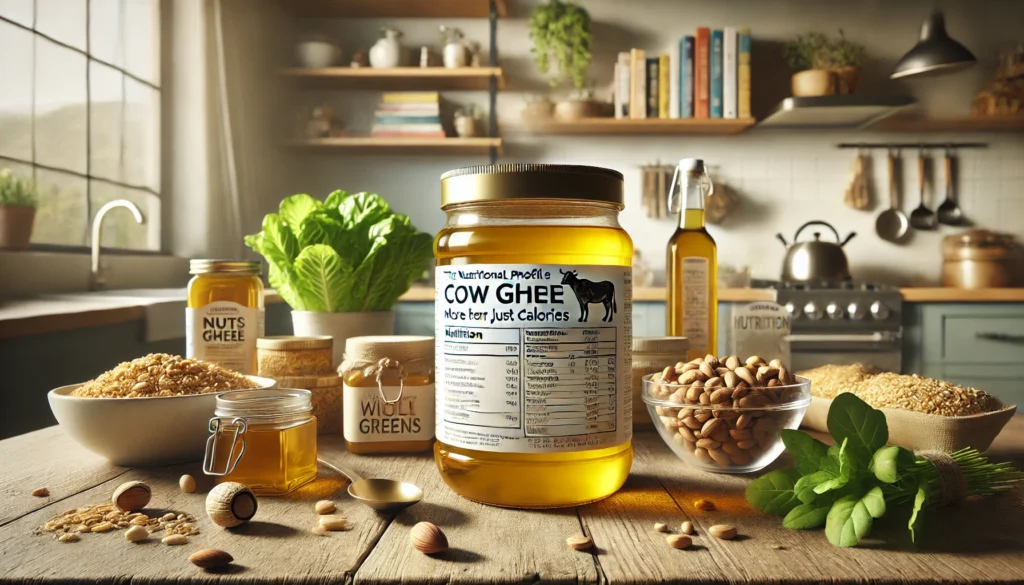
- Key Nutrients in Cow Ghee
Cow ghee is packed with essential nutrients that are beneficial to health. It is particularly rich in:
- Butyrate: A short-chain fatty acid that plays a vital role in gut health, reduces inflammation, and supports metabolism.
- Vitamins A, D, E, and K2: These fat-soluble vitamins are crucial for bone health, immune function, and skin health.
- Antioxidants: Ghee contains compounds that help fight oxidative stress, reduce inflammation, and protect against chronic diseases.
These nutrients make ghee much more than just a source of fat—it’s a nourishing addition to your diet that supports overall well-being.
- Health Benefits Beyond Weight Loss
While ghee’s benefits for weight loss may be debated, its other health benefits are clear. It promotes digestive health, thanks to its butyrate content, which nourishes the gut lining and supports the growth of beneficial gut bacteria. Regular consumption of ghee can also improve skin health, as the essential fatty acids in ghee help to keep skin moisturized and youthful.
Moreover, ghee’s anti-inflammatory properties help reduce joint pain and stiffness, making it a valuable food for those with arthritis or other inflammatory conditions. Additionally, the vitamins in ghee help boost immunity, improving your body’s ability to fight infections and maintain a healthy balance.
The Science Behind Cow Ghee and Fat Metabolism

- How the Body Processes Fats
Ghee is metabolized efficiently by the body, especially because it’s free from milk solids, which can be difficult to digest for some people. The MCTs in ghee are readily absorbed and used for energy, rather than being stored as fat. This makes ghee less likely to contribute to fat buildup around the belly or other areas.
- Ghee and the Keto Diet: A Popular Trend
Cow ghee is a favorite among those following the Keto diet, as it’s a rich source of fat without the carbs. When combined with protein and fiber, ghee can promote fat burning, making it a great addition to meals for weight management. The fat in ghee supports ketosis, the metabolic state where your body burns fat for fuel instead of carbohydrates.
The Impact of Moderation: How Much Cow Ghee Is Too Much?

- Portion Control: Finding the Right Balance
Like all fats, moderation is key. A tablespoon or two of ghee per day is enough to reap its benefits without overdoing it. This small amount can be used in cooking or drizzled over dishes like vegetables, rice, or lentils.
- How to Incorporate Cow Ghee into a Healthy Diet
To get the most out of ghee, use it as a replacement for unhealthy oils and fats. Add it to your morning oats, spread it on toast, or use it to sauté vegetables. When used in combination with whole, nutrient-dense foods, ghee can be a healthy and satisfying addition to your diet.
Cow Ghee vs. Other Cooking Fats: A Comparative Look
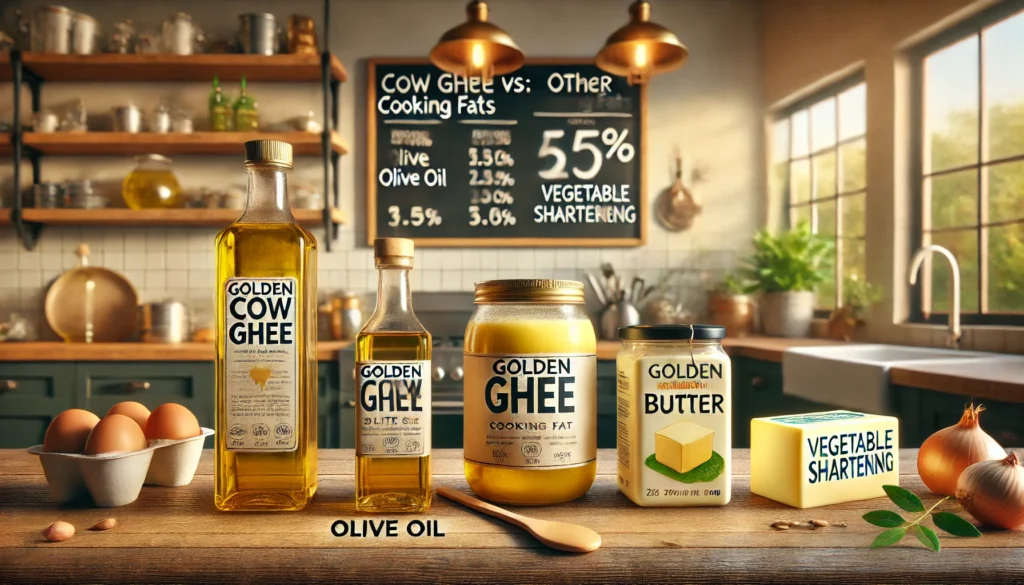
- Ghee vs. Butter
While both butter and ghee are rich in fat, ghee has a higher concentration of butyrate and fat-soluble vitamins, making it more nutritious. It also has a higher smoke point than butter, meaning it’s better suited for high-heat cooking.
- Ghee vs. Vegetable Oils
Refined vegetable oils (like sunflower and canola oil) are often processed with chemicals, losing much of their nutritional value. Ghee, on the other hand, is minimally processed and retains its full nutritional profile. It also contains more stable fats that are better for cooking at high temperatures.
- Ghee vs. Olive Oil
While olive oil is known for its heart-healthy monounsaturated fats, ghee provides a broader range of nutrients, including fat-soluble vitamins and antioxidants. Both oils are healthy, but ghee offers unique benefits that olive oil does not.
Addressing Common Misconceptions About Cow Ghee

- Myth #1: Ghee Raises Cholesterol
Ghee does not inherently raise cholesterol levels, especially when consumed in moderation. It actually contains healthy fats that support heart health when part of a balanced diet.
- Myth #2: Ghee Is Only for High-Calorie Dishes
Ghee can be used in lighter meals too. Add it to soups, stews, or roasted vegetables for flavor and health benefits without adding excessive calories.
- Myth #3: Ghee Is Only for Indian Cuisine
Ghee is incredibly versatile and can be used in a variety of dishes, from baking to sautéing, or even drizzling over salads. It’s not limited to Indian recipes!
Is Cow Ghee Fattening or Not?
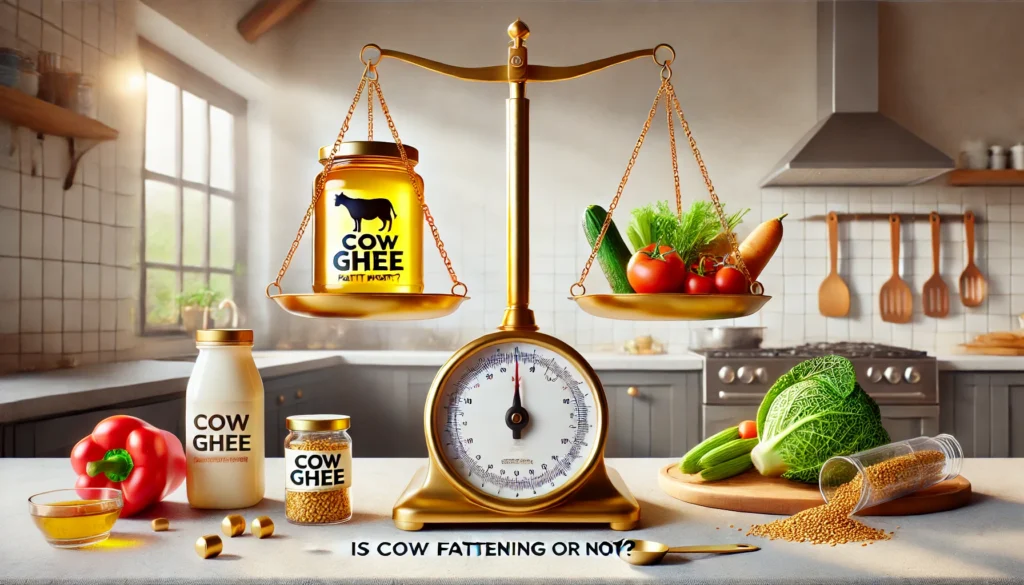
- Summing It Up
Cow ghee is not inherently fattening—it’s all about moderation. When consumed mindfully and as part of a balanced diet, ghee can offer a wealth of health benefits, from improving digestion to boosting immunity.
- The Takeaway
Incorporating ghee into your daily diet can provide essential nutrients, healthy fats, and a rich flavor, without the fear of weight gain. Its versatility in cooking makes it a valuable addition to your pantry. So, go ahead—enjoy the goodness of ghee, but remember: like all foods, moderation is key.
FAQs – Frequently Asked Questions
-
Can I eat ghee if I’m trying to lose weight?
Yes! Ghee, when consumed in moderation and balanced with other nutrients, can aid in weight loss by promoting fat metabolism and providing healthy fats.
-
Is cow ghee suitable for people with lactose intolerance?
Yes! Ghee is free from milk solids, which means it contains very little to no lactose, making it suitable for most people with lactose intolerance.
-
Can ghee be consumed on a daily basis?
Absolutely! A tablespoon or two a day is sufficient to reap the health benefits of ghee.
-
Is ghee better than other oils for cooking?
Ghee has a higher smoke point than most oils, making it a better choice for high-heat cooking. It also offers a more stable fat profile than refined vegetable oils.
-
Is cow ghee good for weight loss?
Yes, cow ghee can be beneficial for weight loss when consumed in moderation. Despite being high in fat, ghee contains medium-chain triglycerides (MCTs), which are quickly used by the body for energy rather than being stored as fat. The key is to use it in balanced amounts as part of a healthy, well-rounded diet. When combined with a nutrient-dense diet and regular physical activity, ghee can support fat metabolism and contribute to weight management.
-
Does cow ghee raise cholesterol levels?
No, cow ghee does not inherently raise cholesterol levels, especially when consumed in moderation. While ghee is rich in saturated fats, these fats are stable and contain beneficial fatty acids like butyrate, which support overall heart health. Some studies suggest that ghee can actually help improve lipid profiles by raising HDL (good) cholesterol levels, but it’s essential to consume it in appropriate portions, ideally no more than one or two tablespoons per day.
-
Can I use cow ghee if I have lactose intolerance?
Yes, cow ghee is typically safe for individuals with lactose intolerance. The process of making ghee removes the milk solids, including lactose and casein, which are the proteins that often cause digestive issues in people with lactose intolerance. Therefore, ghee contains only pure butterfat and is usually well-tolerated by most people who avoid lactose.
-
How is cow ghee different from butter?
Cow ghee is different from regular butter in both composition and nutritional value. While butter contains milk solids, water, and fat, ghee is made by simmering butter to remove the water content and milk solids, leaving only the pure fat. This makes ghee a healthier option for cooking, especially at high temperatures, as it has a higher smoke point than butter. Ghee also has a richer nutrient profile, including vitamins A, D, E, K2, and butyrate, which offer various health benefits that butter does not provide.
-
Can cow ghee be used in cooking for everyday meals?
Absolutely! Cow ghee is a versatile fat that can be used in a variety of cooking methods, from sautéing and frying to drizzling over roasted vegetables or adding to soups and stews. It imparts a rich, nutty flavor to dishes and is a healthier alternative to many vegetable oils and butter. Ghee’s high smoke point makes it ideal for cooking at high temperatures without breaking down into harmful compounds. Just be mindful of the portions, and incorporate it into meals as part of a balanced diet.

